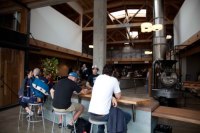fantasy vc - knodes
Continuing a series on startups I'd put a bet on if I could.
At New York Tech Meetup last year I saw a presentation by the founders of Knodes. It got me then and, eight months later, I still think about it.
Facebook, Pinterest, Instagram, etc., are utilities [eventually] optimized for advertising revenue. This means they must generate noise to make money from our captured attention. I’ve asked: what if we were paid directly for our attention rather than those middlemen?
Knodes asks: what if we could use those noise generating systems to generate signal?
Put these things together:
- It’s become a truism that there’s too much information, too much of which is noise and most of which is filtered out automatically by people on social media, in searches, etc
- Word of mouth, recommendations from friends and trusted advice have the greatest leverage when it comes to commanding high-value attention, the kind that leads to actual action and stickiness
- "High-value" attention because all attention is not made equal, which is (hopefully) intuitively self-evident
- The social capital of trusted networks (or whatever)—a friend you know knows a thing or two about something—can turn something from a bit of noise into a bit of signal
- The demographic, interest and activity profile matching used for ad targeting can (and should) be used by trusted networks to reach each other with greater leverage
- For example: I don’t know who in my network is really interested in supporting autism research, but some of them must be so instead of hitting all of them with noise—support this because I want to—I can target the ones that care with a signal—support this because they want to—without having to know who they are ahead of time
In generating signal I wrote:
Instead of us filtering out all the noise to find the signal, the signal filters out everyone to whom it is noise. The signal finds you.
Jeff Jonas has been saying this for more than a decade: the data must find the data and the relevance must find the user. Go read him. If you get the chance, talk to him.
That is the promise of Knodes.
Generate signal.
--
None of this is to say that they're guaranteed success. Or won't get crushed by an incumbent or other party. Or even scooped up before they become too successful. Just that I would've placed that bet.









